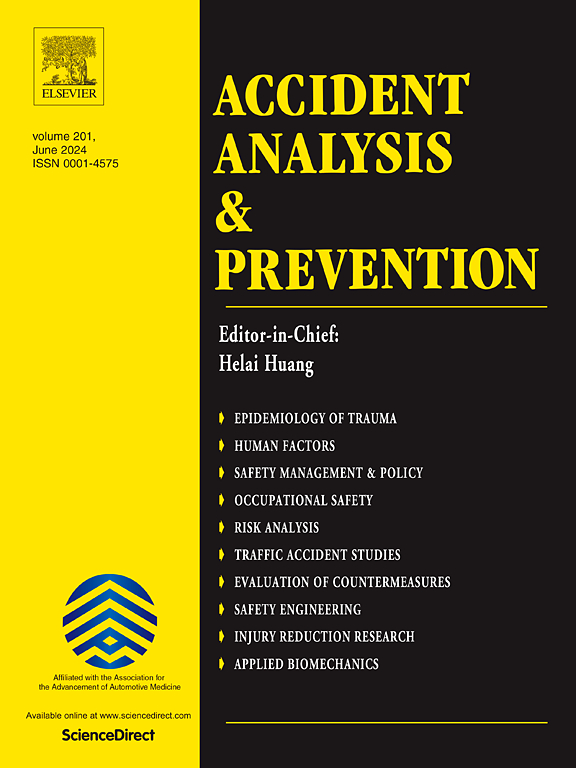Risk of apprehension for road traffic law violations in Norway
IF 5.7
1区 工程技术
Q1 ERGONOMICS
引用次数: 0
Abstract
Violations of road traffic law are widespread in all countries. Probably the most common violation is speeding. It is not uncommon that 50 % of vehicles are speeding. Little is known about the risk of apprehension for various traffic law violations, although it is often assumed that nearly all violations go undetected. This paper quantifies the risk of apprehension for common traffic law violations in Norway, based on data for the period 2006–2022. The violations included are speeding, non-use of seat belts, driving with an illegal blood alcohol concentration (above 0.02 %), driving while impaired by medicines or illegal drugs, use of a hand-held mobile phone while driving and violations of the regulations of hours of service and rest for drivers of heavy vehicles. Risk of apprehension is stated as the number of detected violations per million vehicle kilometres driven while committing the violation. The risk of apprehension is in most cases between 10 and 50 per million vehicle kilometres driven while committing a violation. This is quite low. For speeding, the risk of apprehension was between 10 and 12 per million vehicle kilometres of speeding during 2006–2022. For an average driver, this means that he or she could speed on every trip for about 8–10 years before getting caught. Reducing traffic law violations may contribute to a large reduction of the number of traffic fatalities.
挪威因违反道路交通法而被逮捕的风险。
违反道路交通法的现象在各国都很普遍。最常见的违法行为可能就是超速。50% 的车辆超速并不少见。尽管人们通常认为几乎所有的违法行为都不会被发现,但对各种违反交通法规行为被逮捕的风险却知之甚少。本文根据 2006-2022 年期间的数据,量化了挪威常见交通违法行为的被捕风险。这些违法行为包括超速行驶、不使用安全带、血液中酒精浓度超过 0.02%、服用药物或违禁药物后驾车、驾车时使用手持移动电话以及违反重型车辆驾驶员工作和休息时间规定。上路风险是指在驾驶过程中每行驶一百万公里所发现的违规次数。在大多数情况下,违规驾驶时每行驶 100 万车程的被抓风险在 10 至 50 之间。这是相当低的。对于超速行驶,在 2006-2022 年期间,每百万公里超速行驶的被抓风险在 10 到 12 之间。对于一名普通驾驶员来说,这意味着他或她可以在 8-10 年内每次超速行驶都不会被抓。减少交通违法行为可能有助于大幅降低交通事故死亡人数。
本文章由计算机程序翻译,如有差异,请以英文原文为准。
求助全文
约1分钟内获得全文
求助全文
来源期刊

Accident; analysis and prevention
Multiple-
CiteScore
11.90
自引率
16.90%
发文量
264
审稿时长
48 days
期刊介绍:
Accident Analysis & Prevention provides wide coverage of the general areas relating to accidental injury and damage, including the pre-injury and immediate post-injury phases. Published papers deal with medical, legal, economic, educational, behavioral, theoretical or empirical aspects of transportation accidents, as well as with accidents at other sites. Selected topics within the scope of the Journal may include: studies of human, environmental and vehicular factors influencing the occurrence, type and severity of accidents and injury; the design, implementation and evaluation of countermeasures; biomechanics of impact and human tolerance limits to injury; modelling and statistical analysis of accident data; policy, planning and decision-making in safety.
 求助内容:
求助内容: 应助结果提醒方式:
应助结果提醒方式:


